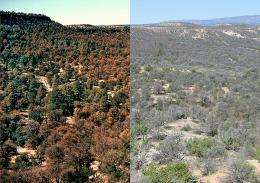Dying trees in Southwest set stage for erosion, water loss in Colorado River

New research concludes that a one-two punch of drought and mountain pine beetle attacks are the primary forces that have killed more than 2.5 million acres of pinyon pine and juniper trees in the American Southwest during the past 15 years, setting the stage for further ecological disruption.
The widespread dieback of these tree species is a special concern, scientists say, because they are some of the last trees that can hold together a fragile ecosystem, nourish other plant and animal species, and prevent serious soil erosion.
The major form of soil erosion in this region is wind erosion. Dust blowing from eroded hills can cover snowpacks, cause them to absorb heat from the sun and melt more quickly, and further reduce critically-short water supplies in the Colorado River basin.
The findings were published in the journal Ecohydrology by scientists from the College of Forestry at Oregon State University and the Conservation Biology Institute in Oregon. NASA supported the work.
"Pinyon pine and juniper are naturally drought-resistant, so when these tree species die from lack of water, it means something pretty serious is happening," said Wendy Peterman, an OSU doctoral student and soil scientist with the Conservation Biology Institute. "They are the last bastion, the last trees standing and in some cases the only thing still holding soils in place."
"These areas could ultimately turn from forests to grasslands, and in the meantime people are getting pretty desperate about these soil erosion issues," she said. "And anything that further reduces flows in the Colorado River is also a significant concern."
It's not certain whether or not the recent tree die-offs are related to global warming, Peterman said. However, the 2007 report of the Intergovernmental Panel on Climate Change projected that while most of the United States was getting warmer and wetter, the Southwest will get warmer and drier. Major droughts have in fact occurred there, and the loss of pinyon pine and juniper trees would be consistent with the climate change projections, Peterman said.
Pinyon pine and juniper are the dominant trees species in much of the Southwest, routinely able to withstand a year or two of drought, and able to grow in many mountainous areas at moderate elevation. The trees are common in Utah, Colorado, New Mexico and Arizona, and may have expanded their range in the past century during conditions that were somewhat wetter than normal.
In some places up to 90 percent of these trees have now died, many of them during a major drought in 2003 and 2004. The new research concluded that most of the mortality occurred in shallow soils having less than four inches of available water in about the top five feet of the soil column.
Most of the tree mortality, the scientists said, was caused by trees being sufficiently weakened by drought that opportunistic bark beetle epidemics were able to kill the pinyon pine, and the vascular system of the juniper ceased to function.
Traditionally, pinyon pine and juniper were not considered trees of significant value. They were occasionally used for firewood, but otherwise small and not particularly impressive.
They perform key ecosystem functions, however, not the least of which is stabilizing soils and preventing erosion. They also provide some food in the form of pine nuts and juniper berries, and store carbon in their biomass, and in the soils beneath their canopies.
Provided by Oregon State University

















